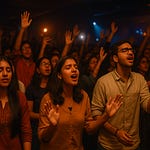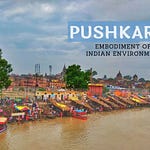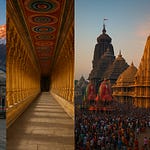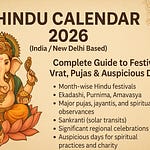Nestled in the tranquil hill town of Almora in Uttarakhand, the Nanda Devi Temple stands as a timeless symbol of faith, devotion, and the rich cultural heritage of the Kumaon region. Revered as the patron goddess of the region, Maa Nanda Devi is worshipped with unmatched reverence, especially during Navratri and the grand Nanda Devi Mahotsav.
This article offers an in-depth exploration of the origin, mythology, history, rituals, festivals, timings, and travel guide to help you immerse in the spiritual experience of this sacred shrine.
🕉️ Origin and Mythological Significance
Who is Nanda Devi?
Nanda Devi is believed to be an incarnation of Goddess Durga or Parvati, the consort of Lord Shiva. In Kumaoni tradition, she is seen as a local deity who protects the region and its people. The name “Nanda” means joy or happiness, and Devi means goddess, symbolizing the divine feminine energy that sustains the universe.
Mythological Story
As per local legends, Nanda Devi is the daughter of the Katyuri dynasty and the consort of Lord Shiva. She is considered a protective deity of the Kumaon Himalayas. A significant part of the legend relates to her journey back to her divine abode in the Himalayas, symbolized during the annual Nanda Devi Raj Jat Yatra, where devotees walk 280 km through the treacherous routes of the Himalayan terrain.
🛕 The Temple and Its Architecture
The Nanda Devi Temple in Almora is over 1,000 years old and is located in the heart of Almora town, close to the famous Lal Bazaar. Built in the Katyuri architectural style, the temple is surrounded by intricately carved wooden and stone structures. It showcases artistic excellence with detailed stone sculptures and wooden carvings, particularly of gods, goddesses, and animals.
The temple stands inside a fortified area, marked by an ornate gateway, and remains one of the most important Shakti Peethas in the Kumaon region.
🙏 Religious Essence and Spiritual Importance
The temple is not just a place of worship—it is the spiritual epicenter for the people of Almora and nearby regions. Devotees believe that Maa Nanda Devi protects their villages from natural calamities, brings prosperity, and blesses them with good health.
The temple plays a central role during Navratri, when thousands of devotees flock here to offer their prayers. The belief in the living presence of the Goddess in the temple sanctum strengthens the faith of her devotees year after year.
🔔 Puja, Rituals & Aarti
Daily Puja
Morning and Evening Pujas are conducted by the temple priests.
Offerings include fresh flowers, coconut, vermillion, sweets, and diya (oil lamp).
Special shringar (decoration) is done for the idol during festivals.
Aarti Timings
Morning Aarti: Around 6:00 AM – 7:00 AM
Evening Aarti: Around 6:30 PM – 7:30 PM
(Timings may vary slightly depending on the season)
Devotees can witness these aartis which involve chanting of Vedic mantras, blowing of conch shells, and the rhythmic beating of temple drums, creating a deeply immersive spiritual atmosphere.
🎉 Festivals and Celebrations
1. Navratri
Navratri is the most celebrated festival at the Nanda Devi Temple. Devotees observe fasting, perform daily rituals, and participate in devotional singing, traditional dances, and spiritual discourses.
2. Nanda Devi Mahotsav
Held annually in August-September, this week-long festival is marked by grand processions, traditional dances, and the installation of beautifully decorated idols of Nanda and Sunanda Devi. It concludes with visarjan (immersion) of the idols in a nearby river, symbolizing her return to the Himalayas.
3. Nanda Devi Raj Jat Yatra (Every 12 Years)
This pilgrimage trek starts from Nauti village and ends at the sacred Roopkund lake, covering nearly 280 km. The yatra signifies the divine journey of Nanda Devi to her heavenly abode and is considered one of the toughest pilgrimages in India.
📜 Historical Background
The temple dates back to the 9th century and was constructed by the Katyuri kings, the then rulers of the Kumaon region. Over centuries, the temple has undergone renovations but retains its original charm and design. Nanda Devi was the family deity of the Katyuri dynasty, and they spread her worship across the region.
The cultural history of Almora is deeply intertwined with this temple, making it a symbol of the Kumaoni identity.
🧭 Travel Guide
📍 Location:
Nanda Devi Temple, Lal Bazaar, Almora, Uttarakhand
🗓️ Best Time to Visit:
Navratri (March–April & September–October) for festivals
March to June and September to November for pleasant weather
🛣️ How to Reach:
By Road: Almora is well-connected to major cities like Kathgodam, Nainital, Haldwani, and Delhi via buses and taxis.
By Train: Nearest railway station – Kathgodam (approximately 82 km)
By Air: Nearest airport – Pantnagar Airport (about 115 km)
🏨 Accommodation:
Numerous hotels, homestays, and guesthouses are available near the temple and throughout Almora, catering to different budgets.
🌄 Nearby Attractions
Bright End Corner – Serene sunset point
Kasar Devi Temple – A spiritual and energy vortex spot
Binsar Wildlife Sanctuary – A nature lover's paradise
Jageshwar Temples – Cluster of over 100 ancient temples
📚 A Temple of Power, Peace, and Devotion
The Nanda Devi Temple in Almora is more than a religious site—it's a journey into the spiritual heart of the Himalayas. Whether you're a devout pilgrim, a curious traveler, or a seeker of inner peace, this temple offers an experience that touches the soul.
By blending ancient legends, rich history, spiritual rituals, and scenic beauty, the temple continues to inspire millions and stands tall as a testament to India’s living traditions.










